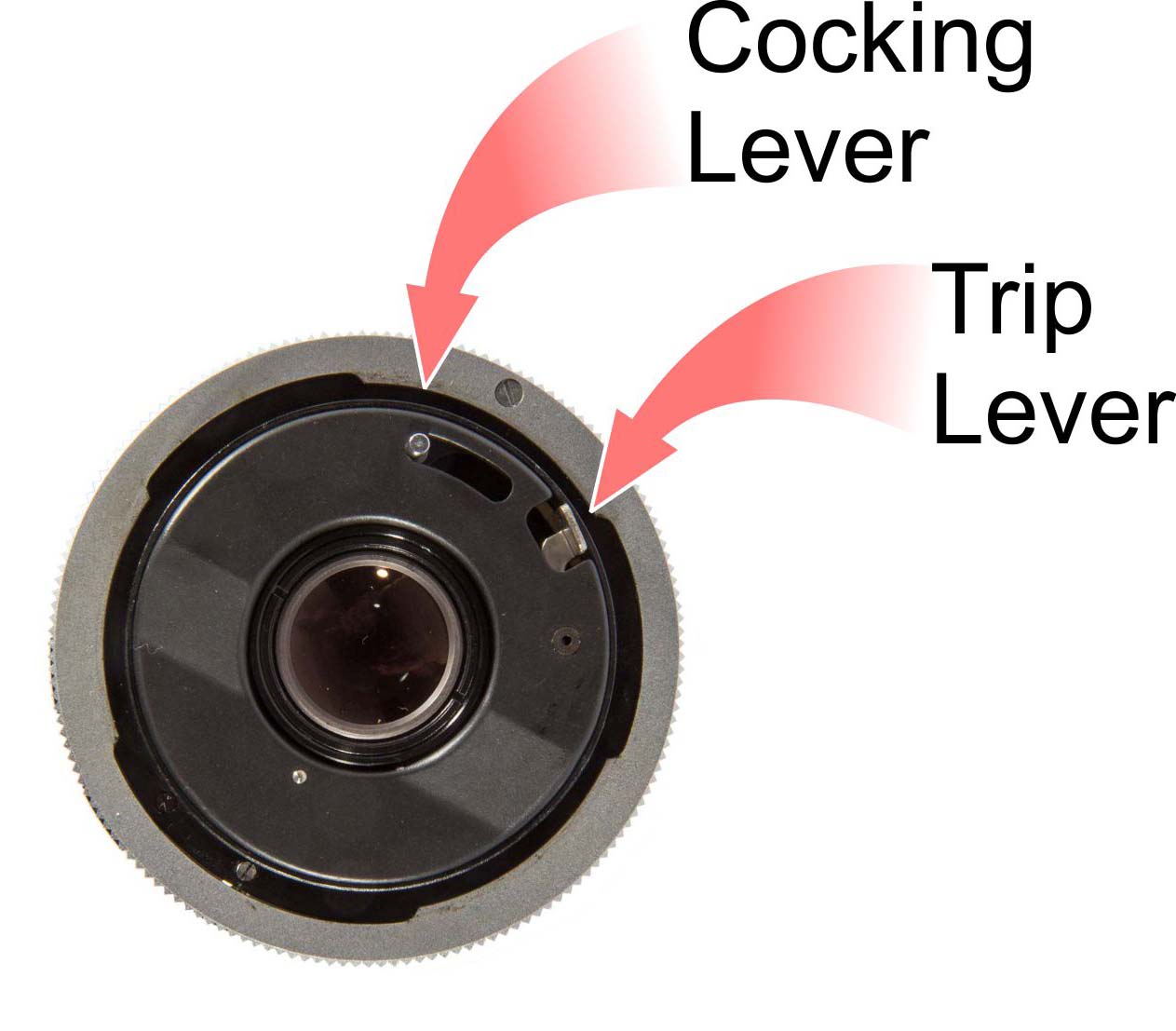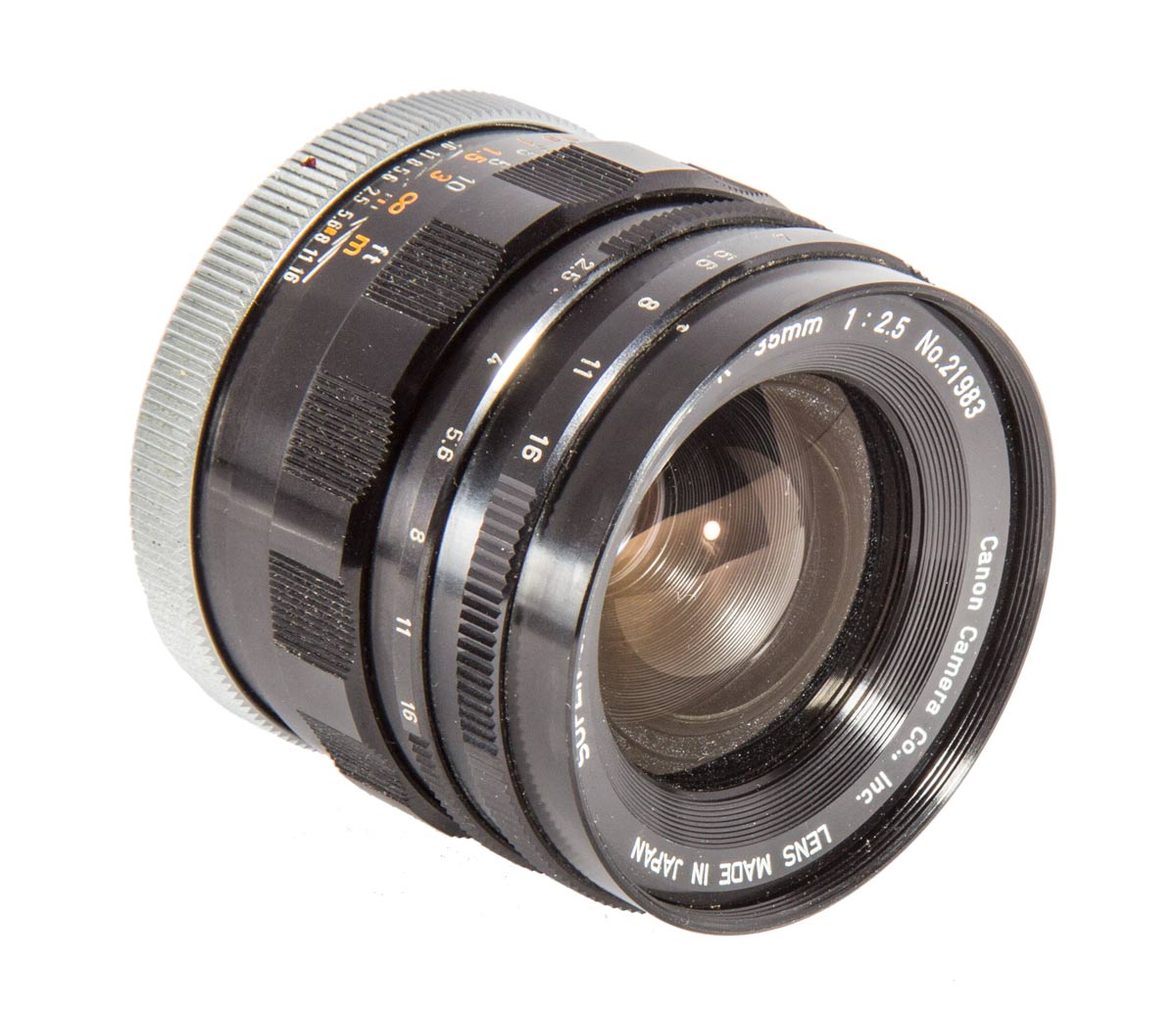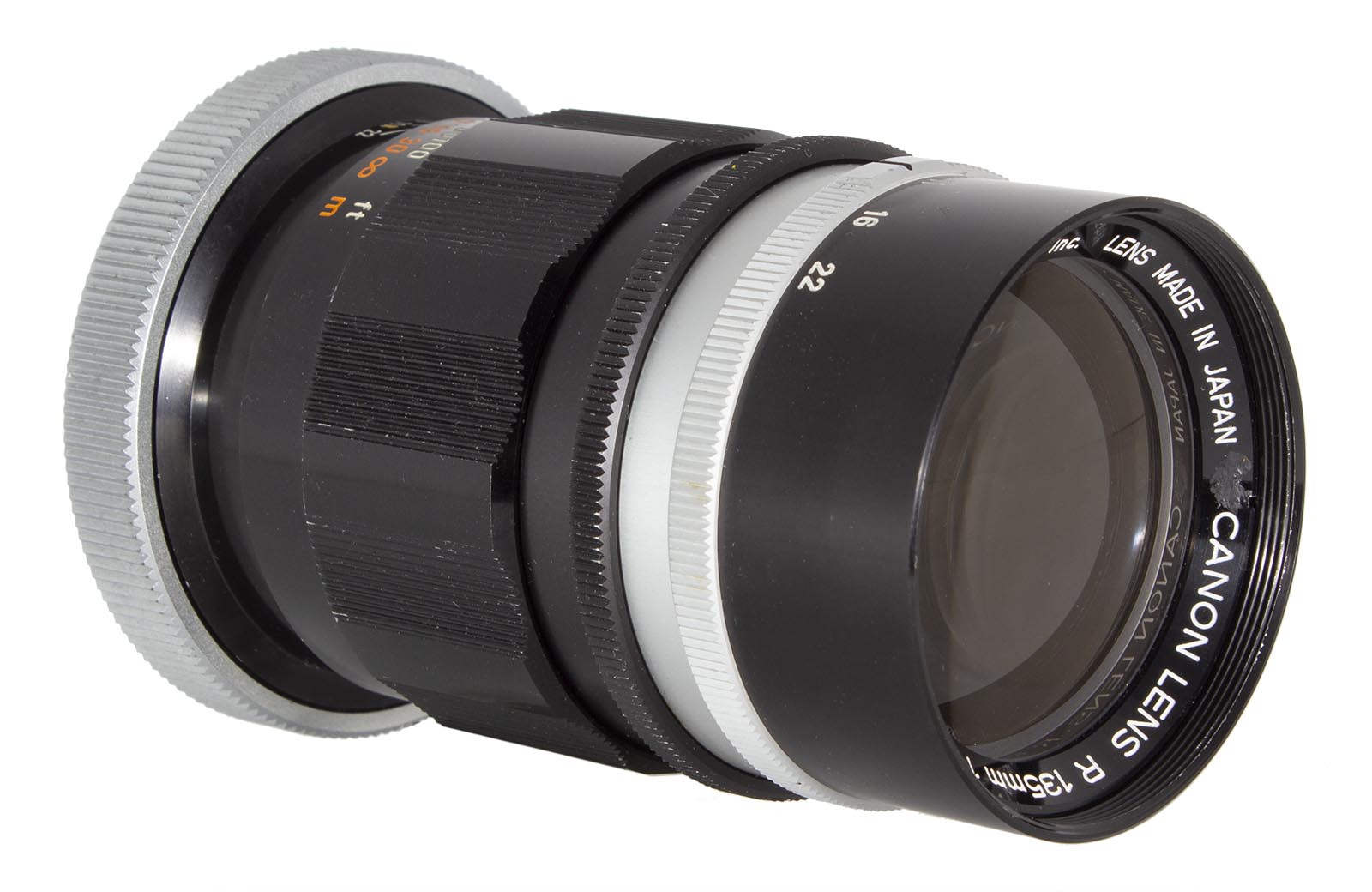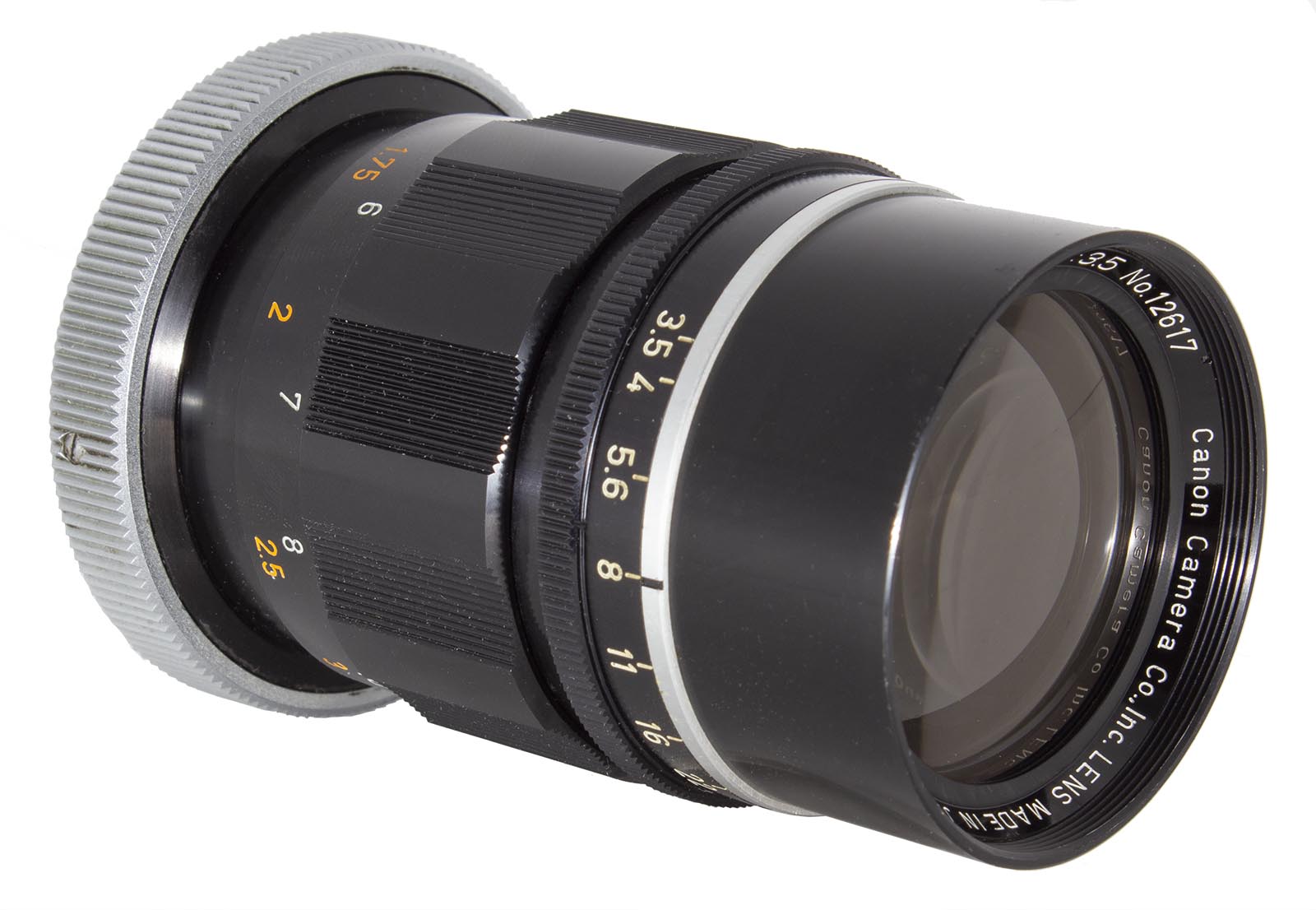The "R" Series of Lenses
The first we just mentioned, the mirror swing. The lens had to be moved further from the film plane so that it did not strike the mirror. This meant redesigning the optics of the lens to focus further from the rear lens element.
The second was the “Through the Lens” (TTL) viewing. Focus was to be accomplished, manually in those days, with the light coming through the lens. The more light coming to the eye the easier this task. So it was desirable to have the lens remain at full aperture until the shutter was pressed. This meant that there had to be communication between lens and camera: the camera had to tell the lens when to close the aperture to the chosen f setting. There was absolutely no way to do this with the rangefinder lenses of the day.
The lens mount that Canon came up with was the “R” series mount which evolved over the next three decades into the FL series mounts, the FD series and the FDn series. The line only came to an end when automatic focusing demanded even more of the lens to camera communication and it became obvious that this venerable line of lens mounts was simply outpaced by technology.

The back of an “R” Lens showing the two operating levers that communicate with the camera body during the exposure cycle.
On the back of the lens there are two levers. The Cocking Lever is pushed by a corresponding lever in the camera when the film is advanced which puts the iris under tension but does not move it. When the shutter is pressed a second arm in the camera body pushes the Trip Lever which releases the Iris and allows it to close. It holds the Trip Lever until the shutter curtain is closed and then releases it. The iris then returns to its widest aperture.

The "R" Series Lenses by Date of Issue
| No. | Name | Released | Min. f/ | Blades | Groups | Elements | Filter | Weight |
| 1 | R 50mm f/1.8 (I) | May 59 | 16 | – | 4 | 6 | 58mm | 295gr |
| 2 | R 135mm f/3.5 | May 59 | 22 | 10 | 3 | 4 | 48mm | 370gr |
| 3 | R200mm f/3.5 | May 59 | 22 | 8 | 5 | 7 | 58mm | 670gr |
| 4 | R 100mm f/2 | Sep 59 | 16 | 6 | 4 | 6 | 58mm | 515gr |
| 5 | R 85mm f/1.9 | Jan 60 | 22 | – | 4 | 6 | 48mm | 355gr |
| 7 | R 400mm f/4.5 | Jan 60 | 22 | – | 4 | 5 | 48mm | 1700gr |
| 8 | R 600mm f/5.6 | Jan 60 | 32 | – | 1 | 2 | 48mm | 2100gr |
| 9 | R 800mm f/8 | Jan 60 | 32 | – | 1 | 2 | 48mm | 1900gr |
| 10 | R 1000mm f/11 | Jan 60 | 32 | – | 1 | 2 | 48mm | 1800gr |
| 11 | R 135mm f/2.5 | Feb 60 | 16 | 6 | 6 | 4 | 58mm | 630gr |
| 12 | R 35mm f/2.5 | Aug 60 | 16 | 6 | 5 | 7 | 58mm | 317gr |
| 13 | R 50mm f/1.8 (II) | Aug 60 | 16 | – | 4 | 6 | 58mm | 305gr |
| 14 | TV 2000mm f/11 | Sep 60 | 11 | 0 | 4 | 7 | 48mm | 10,620gr |
| 15 | R 100mm f/3.5 (I) | May 61 | 22 | – | 4 | 5 | 40mm | 210gr |
| 16 | R 85mm f/1.8 | Oct 61 | 16 | 8 | 4 | 5 | 58mm | 470gr |
| 17 | R 58mm f/1.2 | Feb 62 | 16 | 8 | 5 | 7 | 58mm | 432gr |
| 18 | R 50mm f/1.8 (III) | Apr 63 | 16 | – | 4 | 6 | 58mm | 305gr |
| 19 | R 100mm f/3.5 (II) | Apr 63 | 22 | – | 4 | 5 | 40mm | 210gr |
| 20 | R 55-135mm f/3.5 | Dec 63 | 22 | – | 10 | 15 | 58mm | 790gr |
The "R" Series Lenses by Aperture
| No. | Name | Released | Min. f/ | Blades | Groups | Elements | Filter | Weight |
| 1 | R 35mm f/2.5 | Aug 60 | 16 | 6 | 5 | 7 | 58mm | 317gr |
| 2 | R 50mm f/1.8 (I) | May 59 | 16 | – | 4 | 6 | 58mm | 295gr |
| 3 | R 50mm f/1.8 (II) | Aug 60 | 16 | – | 4 | 6 | 58mm | 305gr |
| 4 | R 50mm f/1.8 (III) | Apr 63 | 16 | – | 4 | 6 | 58mm | 305gr |
| 5 | R 55-135mm f/3.5 | Dec 63 | 22 | – | 10 | 15 | 58mm | 790gr |
| 6 | 58mm f/1.2 | Feb 62 | 16 | 8 | 5 | 7 | 58mm | 432gr |
| 7 | R 85mm f/1.9 | Jan 60 | 22 | – | 4 | 6 | 48mm | 355gr |
| 8 | R 85mm f/1.8 | Oct 61 | 16 | 8 | 4 | 5 | 58mm | 470gr |
| 9 | R 100mm f/3.5 (I) | May 61 | 22 | – | 4 | 5 | 40mm | 210gr |
| 10 | R 100mm f/3.5 (II) | Apr 63 | 22 | – | 4 | 5 | 40mm | 210gr |
| 11 | R 100mm f/2 | Sep 59 | 16 | 6 | 4 | 6 | 58mm | 515gr |
| 12 | R 135mm f/2.5 | Feb 60 | 16 | 6 | 4 | 6 | 58mm | 630gr |
| 13 | R 135mm f/3.5 (I) | May 59 | 22 | 10 | 3 | 4 | 48mm | 370gr |
| 14 | R 200mm f/3.5 | May 59 | 22 | 8 | 5 | 7 | 58mm | 670gr |
| 15 | R 300mm f/4 | Jan 60 | 22 | – | 4 | 5 | 48mm | 1200gr |
| 16 | R 400mm f/4.5 | Jan 60 | 22 | – | 4 | 5 | 48mm | 1700gr |
| 17 | R 600mm f/5.6 | Jan 60 | 32 | – | 1 | 2 | 48mm | 2100gr |
| 18 | R 800mm f/8 | Jan 60 | 32 | – | 1 | 2 | 48mm | 1900gr |
| 19 | R 1000mm f/11 | Jan 60 | 32 | – | 1 | 2 | 48mm | 1800gr |
| 20 | TV 2000mm f/11 | Sep 60 | – | 0 | 4 | 7 | 48mm | 10,620 |




